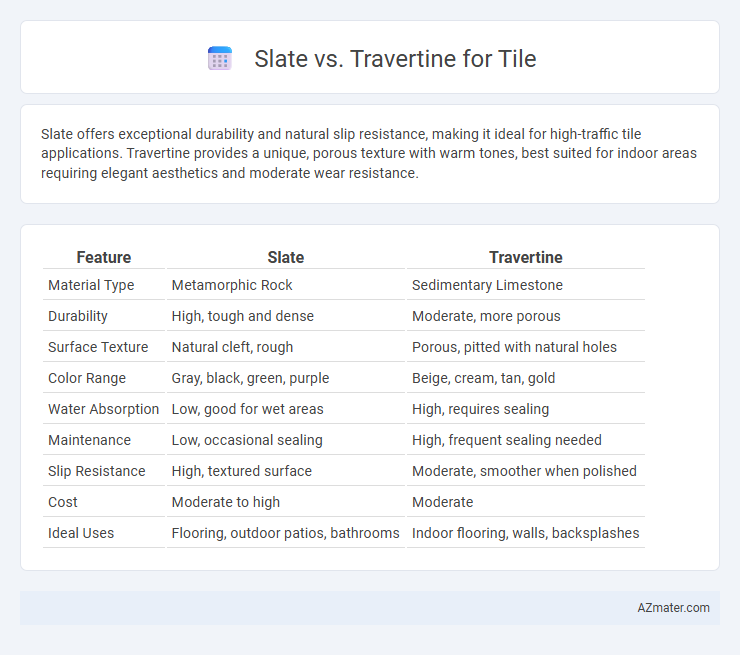Slate offers exceptional durability and natural slip resistance, making it ideal for high-traffic tile applications. Travertine provides a unique, porous texture with warm tones, best suited for indoor areas requiring elegant aesthetics and moderate wear resistance.
Table of Comparison
| Feature | Slate | Travertine |
|---|---|---|
| Material Type | Metamorphic Rock | Sedimentary Limestone |
| Durability | High, tough and dense | Moderate, more porous |
| Surface Texture | Natural cleft, rough | Porous, pitted with natural holes |
| Color Range | Gray, black, green, purple | Beige, cream, tan, gold |
| Water Absorption | Low, good for wet areas | High, requires sealing |
| Maintenance | Low, occasional sealing | High, frequent sealing needed |
| Slip Resistance | High, textured surface | Moderate, smoother when polished |
| Cost | Moderate to high | Moderate |
| Ideal Uses | Flooring, outdoor patios, bathrooms | Indoor flooring, walls, backsplashes |
Introduction to Slate and Travertine Tiles
Slate tiles, composed of fine-grained metamorphic rock, offer exceptional durability and a natural, textured surface well-suited for both indoor and outdoor applications. Travertine tiles, formed from fossilized calcium carbonate deposits, feature a porous, smooth surface with distinctive veining and warm earth tones, providing a classic, elegant aesthetic. Both materials are popular choices in tile flooring and wall applications due to their unique appearance and inherent strength, but they differ significantly in maintenance and slip-resistance properties.
Slate Tile: Characteristics and Appearance
Slate tile showcases a natural, fine-grained texture with a unique layered formation, offering rich variations in color from deep grays and greens to rusty reds and browns. Its durability and resistance to moisture make it an ideal choice for both indoor and outdoor applications. The natural cleft surface enhances slip resistance while providing an elegant, rustic aesthetic favored in flooring and wall installations.
Travertine Tile: Characteristics and Appearance
Travertine tile features a unique, porous surface with natural pits and troughs, giving it a rustic and textured appearance ideal for both indoor and outdoor applications. Its warm, earthy tones ranging from creamy beige to rich caramel enhance traditional and Mediterranean-style designs. Durable yet softer than slate, travertine requires sealing to protect against stains and moisture while maintaining its natural beauty over time.
Durability Comparison: Slate vs Travertine
Slate offers superior durability compared to travertine, as it is denser and more resistant to scratches, chips, and stains, making it ideal for high-traffic areas. Travertine, while still durable, is softer and more porous, requiring regular sealing to prevent damage from moisture and wear. For long-lasting tile applications, slate's hardness and natural cleft surface provide enhanced strength and longevity over travertine.
Maintenance Requirements for Slate and Travertine
Slate requires regular sealing to prevent moisture absorption and staining, with routine cleaning using a pH-neutral cleaner to maintain its natural texture and color. Travertine also demands sealing but is more prone to etching and surface damage from acidic substances, necessitating gentle cleaning and prompt spill removal. Both materials benefit from avoiding harsh chemicals, but slate's denser composition often translates to lower long-term maintenance compared to the porous nature of travertine.
Installation Process: Slate vs Travertine
Slate tiles require meticulous surface preparation and strong adhesive due to their dense, uneven texture, with grout lines needing careful sealing to prevent moisture infiltration. Travertine installation demands a level substrate and the use of a pH-neutral adhesive to avoid stone damage, while its porous nature necessitates deep sealing post-installation. Both materials involve labor-intensive processes but differ in handling requirements, with slate tolerating more surface irregularities and travertine needing precise leveling.
Cost Analysis: Slate vs Travertine Tiles
Slate tiles typically range from $5 to $15 per square foot, offering a durable and affordable option for flooring and walls, while travertine tiles generally cost between $7 and $20 per square foot due to their elegant appearance and natural variations. Installation costs for both materials can vary, but slate often demands higher labor expenses because of its density and weight, whereas travertine's softer texture allows for easier cutting and fitting, potentially reducing labor time. Maintenance costs also differ, with travertine requiring more frequent sealing to prevent staining, adding to long-term expenses compared to the relatively low upkeep slate demands.
Water and Weather Resistance
Slate offers superior water resistance due to its dense, non-porous structure, making it ideal for wet environments and outdoor applications. Travertine, while aesthetically pleasing with its natural veining, tends to be more porous and requires sealing to prevent water absorption and weather-related damage. Both materials perform well with proper maintenance, but slate holds a natural advantage in durability against moisture and harsh weather conditions.
Best Applications: Where to Use Slate and Travertine
Slate tiles excel in high-traffic areas such as kitchens, entryways, and bathrooms due to their durability, natural slip resistance, and ability to withstand moisture. Travertine tiles are ideal for indoor living spaces like dining rooms and hallways, as well as outdoor patios and pool surrounds, offering a softer, classic aesthetic with a more porous surface that requires sealing. Both materials perform well in wet environments when properly maintained, but slate is preferred for heavy-use zones and travertine suits decorative and moderate-traffic settings.
Conclusion: Choosing Between Slate and Travertine Tiles
Slate offers superior durability and a rich, textured appearance ideal for high-traffic areas and outdoor use, while travertine provides a smoother, more elegant finish suitable for indoor spaces with moderate foot traffic. Both natural stones require regular sealing to maintain their beauty and prevent staining, but slate's higher density gives it an edge in resistance to wear. Selecting between slate and travertine tiles depends on balancing aesthetic preferences with the specific functional demands of the installation environment.

Infographic: Slate vs Travertine for Tile
 azmater.com
azmater.com